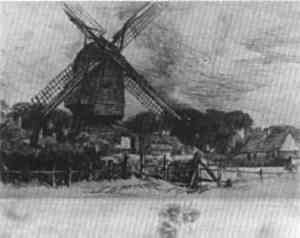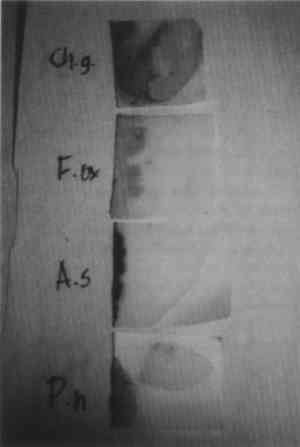LASER STAIN REMOVAL OF FUNGUS-INDUCED STAINS FROM PAPERHANNA MARIA SZCZEPANOWSKA, & WILLIAM R. MOOMAW
2 TREATMENT METHODFour strains of fungi commonly encountered on artworks on paper were selected for the experiment. Each of the fungi is characterized by the production of different colored stains. Fungus Alternaria solani produces a dense black stain, Fusarium oxysporum a pinkish stain, Penicillium notatum a light green stain, and Chaetomium globosum a brownish gray stain. The first three listed fungi were cultured on potato-dextrose agar medium; Chaetomium globosum was cultured on V-8 juice–agar medium. Fungal stains were secreted to the paper samples placed in individual Petri dishes (see Szczepanowska and Lovett 1992). Wove paper of medium weight, manufactured by Rives and Arches, was selected for the experiments. Cultivation of fungi and production of stains were carried out in an optimal environment, at a pH of 6 at 24�C and with exposure to the light from a standard fluorescent lamp for 8 hours per day for 21 days. This technique produced dark stains that appear identical to those found on paper documents and works of art (fig. 1). In addition to the stains induced on paper samples, dark stains on actual artworks were also treated in these studies. Prominent, dark staining is found on the margins of a 19th-century Flemish etching by M. L. Morcari (fig. 1). Although there was no fungal residue that would allow us to identify the fungus left on the artwork, based on the color and pattern, the species most likely responsible for the stain is Alternaria solani.
Each stain was photographed before and after exposure to laser light using a Cannon A1 camera with a macro lens FD 50mm 1:35 and 35mm Kodachrome daylight film, 400 ASA. Examples of the four types of induced stains are shown in figure 2 prior to treatment. The treated stains were also examined under magnifications of 30–60x using a Wild Heerbrugg binocular microscope and photographed with a Nikon N200 camera using 160 ASA Ekta-chrome tungsten film with a light source Intralux 250HL, Volpi AG. Comparison of Alternaria stains with laser-treated areas under increasing optical magnification is illustrated in figure 3. The effect of laser treatment on the fungal residue and paper structure was determined by scanning electron microscopy using a model 100 Cambridge Stereo scanner at magnifications of 500–3000x (see figs. 4–6).
The intense green light, at a wavelength of 532 nm from a Quantel model YG580 neodymium YAG pulsed laser, was aimed at a Typical average power for the YAG laser was about 1.6 watts. The dye laser used Rhodamine 6G as the lasing dye, with a maximum measured average power output of 0.26 watts at 566 nm. With the high powers of the YAG laser, burning of the paper was found to occur if the repetition rate exceeded 10 pulses per second for 1.5 seconds. Focusing the beam with a lens also increased the power density to the point that burning and other damage was observed. The unfocused beam of the YAG laser typically cleaned a small circle of stain about 4 mm in diameter. It is strongly recommended that treatment begin at low power and slow pulse frequencies, utilizing the minimum laser beam intensity that is effective in order to avoid damage to the ink or paper. |

